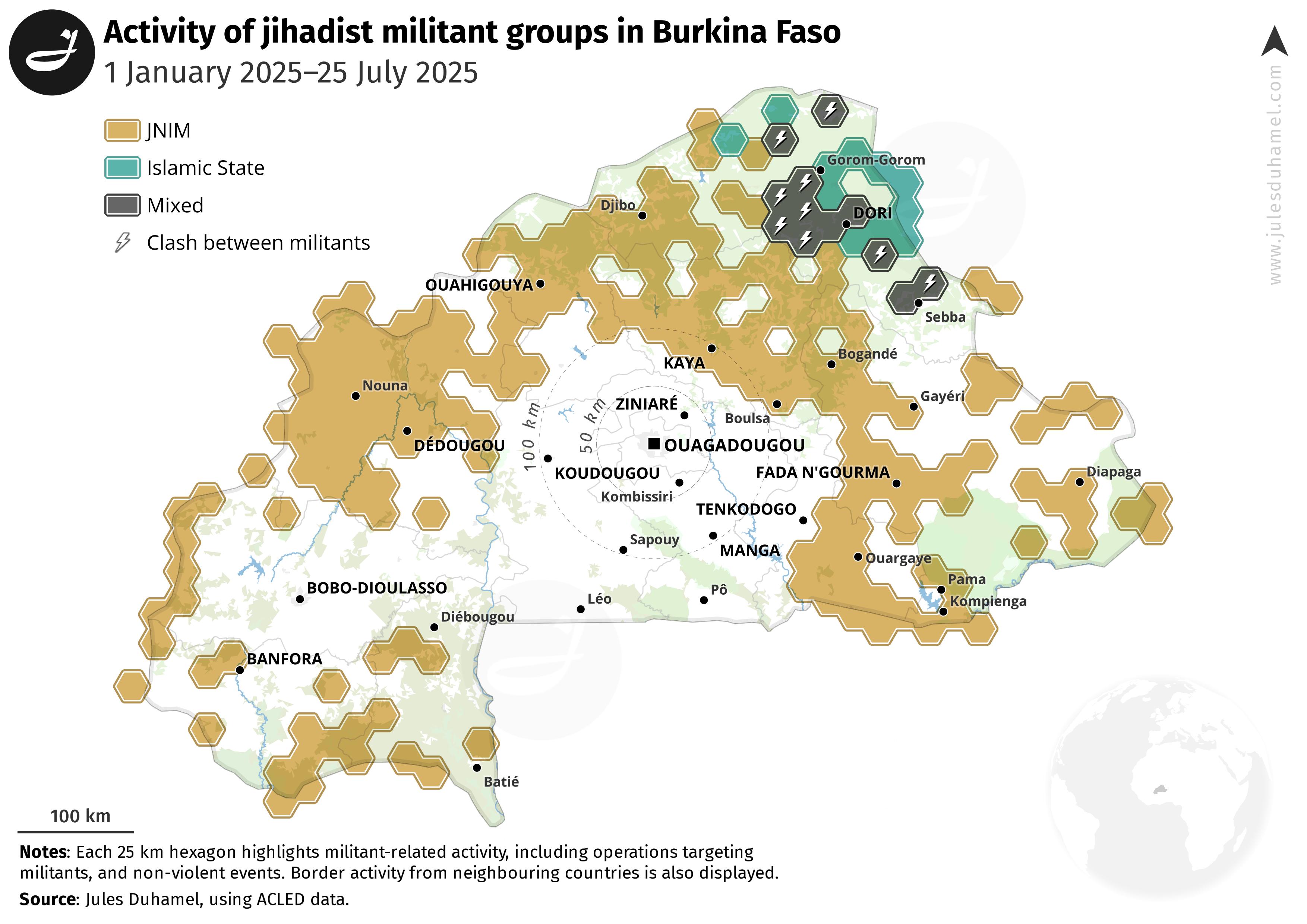Conflict Map of Burkina Faso 2025


Alex Cartwright
Senior Cartographer & GIS Specialist
Alex Cartwright is a renowned cartographer and geographic information systems specialist with over 15 years of experience in spatial analysis and data...
Geographic Analysis
What This Map Shows
The "Conflict Map of Burkina Faso (2025)" reveals the ongoing and emerging conflicts within the country, highlighting areas most affected by violence and instability. This visualization not only delineates regions of conflict but also provides insights into the underlying causes, key players involved, and the socio-political landscape contributing to these tensions. Understanding these dynamics is crucial for comprehending the broader implications of conflict in Burkina Faso and the Sahel region as a whole.
Deep Dive into Conflict in Burkina Faso
Burkina Faso, a landlocked country in West Africa, has faced escalating violence and insecurity in recent years, particularly since 2015. The conflicts depicted on the map are primarily driven by a complex interplay of factors including ethnic tensions, religious extremism, and socio-economic challenges. The rise of militant groups affiliated with al-Qaeda and ISIS has exacerbated these issues, leading to a significant deterioration in security.
Interestingly, Burkina Faso's conflicts are not simply about the clash of arms; they often stem from deeper grievances. For instance, the Fulani herders and the predominantly Mossi farmers have experienced increasing tensions over land use and resources, especially in the face of climate change that has led to droughts and desertification. This has resulted in violent clashes, further complicating the ethnic dynamics within the country.
According to the United Nations, over 1.5 million people were displaced as of late 2023 due to violence and insecurity, with the northern and eastern regions being the most affected. These areas are characterized by a high prevalence of attacks on civilians, which have disrupted livelihoods and exacerbated humanitarian crises. The map highlights hotspots such as the Soum and Sahel regions, where insurgent activity has surged, causing significant fear and instability among local populations.
The impacts of these conflicts are multifaceted. Economically, they hinder development and exacerbate poverty levels. Socially, they fracture communities and foster mistrust among different ethnic groups. Politically, the government struggles to assert control and maintain authority, often leading to a cycle of violence that is hard to break. International organizations and local NGOs are increasingly involved in peacekeeping and humanitarian efforts, but the challenges remain daunting.
Regional Analysis
Examining the conflict map reveals stark regional disparities in Burkina Faso. The northern regions, particularly Boucle du Mouhoun, have seen a sharp increase in violence, with armed groups launching frequent attacks on security forces and civilians. For example, in 2024 alone, reports indicated that clashes resulted in hundreds of deaths and numerous injuries, further destabilizing the area.
Conversely, the southern regions, such as the Cascades and Hauts-Bassins, have remained relatively more stable, although they are not entirely immune to spillover effects from the violence in the north. Interestingly, the capital, Ouagadougou, while facing its own security challenges, has been a focal point for dialogue and peace initiatives, drawing attention from international partners eager to support stabilization efforts.
These regional variations highlight the importance of localized strategies in addressing the root causes of conflict. While some areas may require military intervention, others may benefit from economic development and community engagement initiatives aimed at fostering dialogue and reconciliation among conflicting groups.
Significance and Impact
Understanding the dynamics of conflict in Burkina Faso is crucial not only for the country itself but also for the broader Sahel region, which has been plagued by instability. The implications of continued violence are profound, affecting regional security, humanitarian conditions, and international relations. As neighboring countries like Mali and Niger face similar challenges, the potential for a spillover of violence cannot be underestimated.
Moreover, the international community's response, including efforts from the United Nations and the African Union, is vital in promoting peace and stability. However, as we look towards the future, the question remains: can Burkina Faso's government, with international support, forge a path toward lasting peace? The trends observed in 2025 will be critical in shaping the country's trajectory as it navigates these turbulent waters.
In conclusion, the conflict map of Burkina Faso serves as a stark reminder of the challenges faced by the nation. By understanding the factors at play, we can better appreciate the complexity of the situation and the urgent need for effective solutions that prioritize peace and development for all Burkinabé citizens.
Visualization Details
- Published
- August 12, 2025
- Views
- 150
Comments
Loading comments...